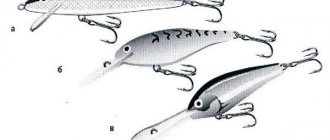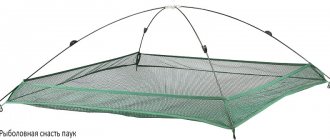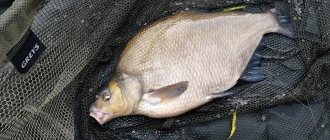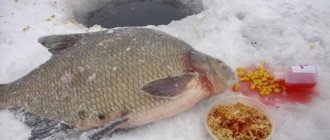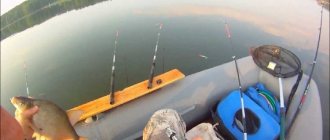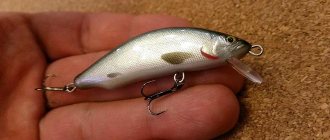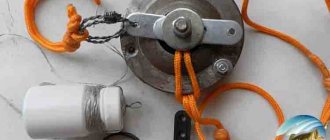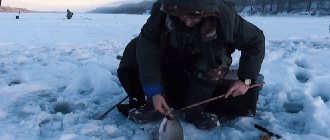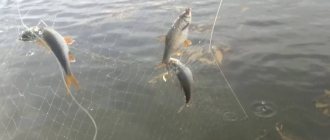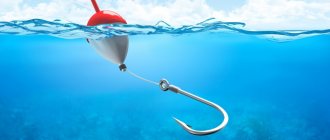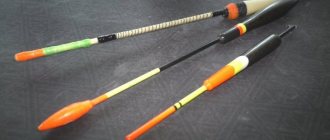Some doners believe that equipping a rocker arm for a feeder is not necessary. Others use this rig and catch fish with it. In this article, we will look at what a feeder beam is and whether it is worth using it at all in this equipment. The correct feeder is fishing with one hook, and the use of more hooks is not justified. However, the rocker is often used by bottomers who are just starting their journey in the feeder, using this equipment as a well-tested option.
Types of rocker for fishing in winter
Using a rocker rig can significantly increase your chances of catching when fishing from ice. It works where other equipment is powerless. By using a rocker, you can simultaneously experiment with different types of bait. Another significant advantage of the tackle is the installed feeder, which holds the fish at the fishing point. Depending on the material of manufacture, there are two types of rocker arms, each of which has its own distinctive features.
Rocker arm made of insulating wire
To assemble a yoke for large bream in winter, you do not need to have any special skills. It is enough to prepare the necessary materials, tools, and follow the following technology:
- Take a piece of insulation from an electrical wire up to 150 mm long.
- Pass the vein through the hole in the tube.
- Attach sharp hooks to both ends of the workpiece, maintaining a distance of 5–7 cm from the tube.
- Crimp the workpiece with a lead strip; it will act as a weighting agent or load.
- Fix the resulting equipment to the main fishing line. It is convenient and effective to introduce a carabiner here.
To increase the chances of catching on ice, it is recommended to make several options for equipping the rocker, with different loads and hooks.
Wire rocker
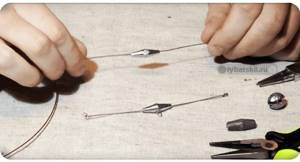
Assembling a wire structure is also easy. The following stages of work must be followed:
- Prepare a wire with a diameter of 1.5-2 mm and a length of 20 cm.
- Make a template device for ease of making bends.
- Draw a drawing of the blank on the wooden surface.
- Drive in 5 nails with a diameter of 3 mm in the bend areas. In total, the length of the equipment will be about 140 mm.
- Using a mock-up, make a wire rig, providing a loop along the edges, as well as in the center of the workpiece.
- Remove the equipment from the layout, remove excess wire using pliers/cutters.
- Give the workpiece its final shape.
To equip a wire rocker, you need to pass a monofilament or braided cord through three loops. There should be enough line at the ends to secure hooks numbered 4-5. It is necessary to calculate in such a way that there is 3-4 cm from the hooks to the rocker. Here it is necessary to ensure the free passage of the fishing line through the rings of the tackle.
The rocker arm is mounted to the main vein using the central ring. A load in the form of pellets is attached next to the equipment.
Store products
Fishing stores sell ready-made equipment. But more often than not, there is always something wrong with them - either the hooks are large, or the leashes are made of thick braid. Fishermen customize them to suit their needs. It is not difficult to make the desired product entirely with your own hands at home.
Manufacturing of rocker arms with blind equipment
Catching bream on a rocker in winter is most often done with this type of gear. And this justifies itself in those reservoirs where bream strikes boldly and confidently. When pulling, it moves the entire rig, along with the sinker, often catching itself. The fisherman only needs to hook it. Let's look at how to make a rocker for catching bream in winter with tightly tied leashes.
There are as many manufacturing options as there are fishermen’s fantasies. There are as many manufacturing options as there are fishermen’s fantasies. But there are two main varieties. In the first case, rings are twisted at the ends of the shoulders, to which leashes are tied. In the second there are no these rings, the leashes are attached to the middle of the rocker arms, and are spread over the shoulders by putting cambrics or rubber (silicone) tubes on the wire.
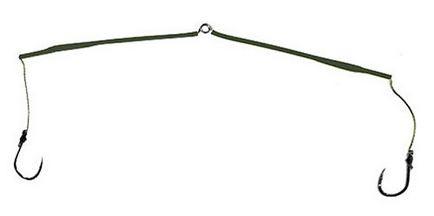
You can make a rocker where both arms are a single plastic tube (insulation from the electrical wire) through which the fishing line is passed. Hooks are tied at both ends, and the length of the leash is limited by a bead or stopper. The value of such an invention is unclear; in fact, it is an unfinished sliding version. The only plus is that this configuration is assembled on the knee without tools, so to speak, an emergency option.

The rocker arm is made from a piece of elastic steel wire (preferably stainless steel) or a metal pike leash. Copper wire is not suitable as it is too soft. To do this, you need pliers and a nail with a diameter corresponding to the required size of the rings. The configuration is not so important - the main thing is that the shoulders are 6-8 centimeters.
The ends of the wire are treated to remove burrs; some fishermen simply seal them with tin. This is necessary so that the fishing line in the places where the leashes are tied is not damaged. A weight is fixed in the middle of the product, the weight of which is determined by the strength of the current and the depth at the fishing site. The lighter the load, the more sensitive the tackle, but the more difficult it will be for the rig to stay in the current.
Higher along the line you can install a sliding feeder - a spring, a box, etc. Leashes made of fishing line about 14 - 0.25 mm (depending on the body of water and the intended trophy) are tied to the rings. The length is selected so that the hooks cannot catch on each other.
Rocker with sliding leads
A winter bream yoke with a sliding rig is undoubtedly a more sensitive option. If there are no bites on a blind mount, but when checking the nozzle it turns out that someone “chewed” it, then this is exactly the problem. In this case, you need to switch to using advanced equipment. It can be made in two versions.
The first option is a regular rocker with three rings. The leads pass freely through the end rings, and both into the middle ring. Next, they are connected in a loop to loop with the swivel and the main fishing line. The working length of the leashes is limited by stoppers (so that the yoke does not run directly onto the hooks). A stopper is also placed in front of the swivel. During manufacturing, it is necessary to carefully process and secure all elements of the wire through which the fishing line passes.
The rings must be made very carefully, without sharp edges or jagged edges that could damage the fishing line. You should also pay attention to the weighting material (sinker). The fishing line should not cling to it when pulling. This type of gear has good sensitivity. When the fish bites, they do not feel the weight of the sinker and act immediately on the nod. This is very important when fishing for white bream and large, extremely cautious bream in winter.
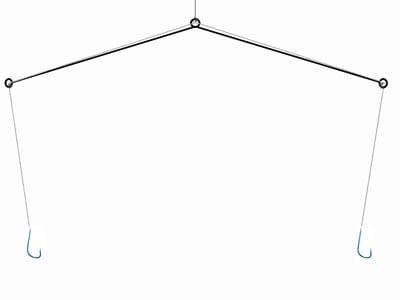
Sliding through rings
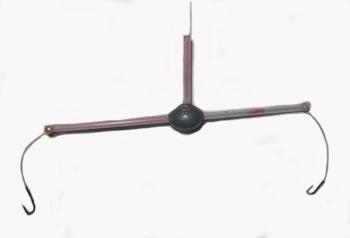
Sliding through tubes
The second design is made of hard plastic tubes, the leads are passed up to the main line through the core of the sinker along these shoulders. The principle of operation is the same.
Winter rocker equipment
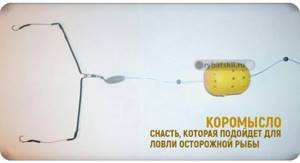
Tackle with a rocker for winter fishing is great for catching wary fish. At the moment of swallowing the bait, the prey does not feel any tension or resistance and swallows it deeply along with the hook. This method is especially popular among whitefish fishermen; it uses two bait options, which makes it possible to quickly determine the tastes of bream in a particular body of water. The tackle is completed with a rod, line and weight.
Rod
You don’t need to buy expensive models; a simple tool with a foam handle is enough. The material of the handle is very important in extreme conditions; there should be no feeling of discomfort or difficulty in use. The foam handle does not slip and does not collapse at low temperatures. Considering that the fishing is stationary, you need to prepare a special stand in the form of goat horns for the rod. A nod for the rocker arm is also necessary. It should be a guard with increased sensitivity and flexibility. The best option is a lavsan nod, which attracts with its budget and sufficient information content.
Weight
It should be selected according to specific hunting conditions. If fishing is planned at a serious depth, in a river, then you should use a heavy load weighing 10–12 g, otherwise the tackle will simply be blown away from the given horizon. To catch bream in reservoirs with calm water, a light weight weighing up to 4 g is enough. Most often, a ball-pellet is used for the rocker.
fishing line
In order not to cause the equipment to break, you need to choose a strong but thin vein. If you use weak threads, then during the fishing process they will easily be damaged on the edge of the ice and the trophy will be secured. It is ideal to use a braided cord with a diameter of 0.05 mm or a monofilament with a thickness of 0.25 mm or more in winter.
On the market and specialized retail outlets, rocker arms are presented in huge quantities, and are suitable for fishing all year round. But if you wish, you can make effective equipment with your own hands at home.
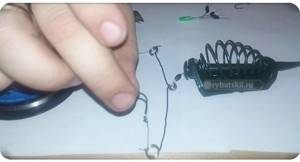
How the tackle works
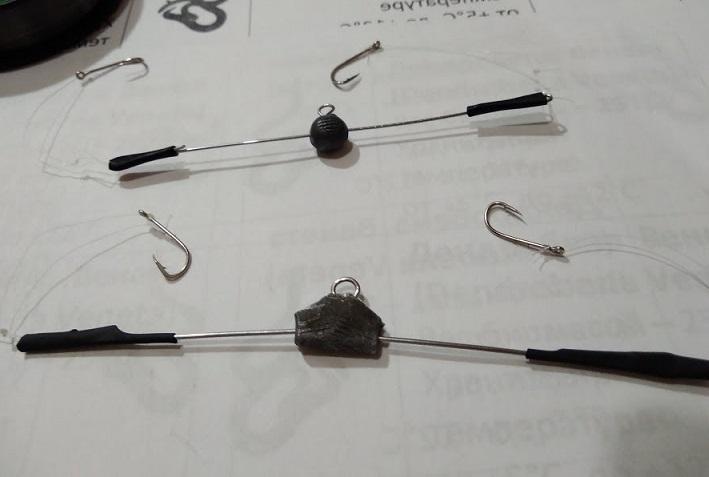
Thin braid will be even more preferable due to its greater softness. This gear consists of the following parts:
- 2 arms with rings at the ends, each 2–6 cm long;
- Suspension – a ring with a diameter of 4–5 mm, located between two shoulders;
- Sinker - a lead “olive” vertically fixed below the suspension, weighing from 2 to 10 or more grams;
- 2 leashes 4-5 cm long made of monofilament with a cross-section of 0.12-0.14 mm or winter braid with a thickness of 0.06 mm.
- Hooks No. 12–14 of red color made of thin wire are tied to the ends of the leashes.
To prevent twisting of the main line, a small swivel with a carabiner is attached to the suspension. The rocker is attached to the main fishing line with a cross-section of 0.18-0.20 mm, wound on the reel of a winter fishing rod with a handle. A large composite winter bream float serves as a signaling device when ice fishing with such gear.
Selecting a location
Depending on the period of winter, you need to look for bream:
- On the first ice, when fishing for bream, areas with a depth of 2–3 m are often productive. The working area should be developed in a checkerboard pattern, drilling 10 or more holes. Particular attention should be paid to bottom surface anomalies, depth differences, entrances/exits to pits, underwater plateaus, and channel edges.
- During the deep winter period, bream is at depth; it is promising to fish in areas with a depth of 6–10 m. You can also get decent results on sharp drops from the shallows to depth. In most cases, large specimens are found.
- During the last ice, when the oxygen concentration in the water increases significantly, you should look for bream in deep flowing depressions, near springs and springs. Fish can also live in areas where non-freezing streams and rivers flow. If hunting is planned at night, then you need to fish at a depth of 2–4 m.
Rocker arm in bottom equipment and in feeder
The yoke rig is a metal outlet for two short leashes with hooks. Typically used in donks and zakidushki. On short leashes you can place regular bait, foam balls or floating boilies. The wire lays on the bottom, and the bait with negative buoyancy rises to the length of the leader. A rocker arm is usually placed on the feeder when fishing with it as a donkey or at the initial level of the English method of fishing. Adherents of the pure feeder are sure that this is a version of “bludgeoners”, and special equipment must be used in the feeder. More information about feeder installations:
Baits
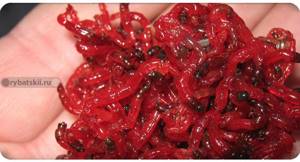
To catch bream in winter on a rocker, you can use bait of both animal and plant origin. Among baits, bloodworms take pride of place. It is often added to winter bait for bream, as the main component in attracting fish across the ice. You can buy bloodworms at any specialized store.
But it is quite affordable to get this bait with your own hands. It is enough to make a hole with a diameter corresponding to the size of the container with holes used. You need to lower it to the bottom, scoop up the soil and pull it to the surface. As a result, the sludge will be washed away, and you only need to select the larvae with a small nylon net. For storage, choose either a refrigerator or a cool cellar.
In addition to bloodworms, bream responds well to:
- worm;
- maggot;
- caddis larva;
- burdock moth larva.
Of the plant attachments, the most effective are:
- semolina chatter;
- dough for winter fishing;
- bakery products;
- pasta;
- steamed wheat grains;
- Hercules;
- pearl barley.

To prepare a universal bait, you need to fill the thermos 1/3 of the total volume with pearl barley. Pour boiling water over and close with a lid. The grains can be used after 3-4 hours. You can catch bream in winter using hard pearl barley, but if it is inactive, then it should be soft. To enhance the effect, the bait is scented.
What does it look like?
Let's say the fishing place is not a river with a moderate or strong current, but a reservoir or pond where there is no current. After casting a feeder with a loop rig, an almost meter-long leash sinks for a long time to the bottom of a deep reservoir, twisting along the way, and already at the bottom the rig, if it does not get overwhelmed, will lie in a lump of fishing line without the influence of the current. Make a shorter leash? Yes, this is a solution to the problem, but most likely not a radical one. Overlapping and tangling will still occur. To some extent, additional winding of the fishing line at the base of the leash can help prevent tangling. But, nevertheless, loop rigs are more acceptable to use on rivers with a current.
Bait and proper feeding
You can attract the attention of bream and keep it at the fishing point with the help of ready-made bait compositions, and by using a mixture prepared by yourself. There are several effective baits:
- Steam the pea grains until fully cooked and pass through a meat grinder. While hot, combine the porridge with breadcrumbs. For flavorings, use a couple of drops of anise.
- The universal version consists of 500 g of millet, 600 g of breadcrumbs, 250 g of rolled oats, 150 g of crushed fried seeds. It is better to flavor the mixture with vanilla in the amount of ½ tsp. Immediately upon arrival at the pond, add maggots and bloodworms to the bait.
- The easiest way is a mixture of breadcrumbs (500 g) and semolina (300 g). All components are mixed and used to fill the feed.
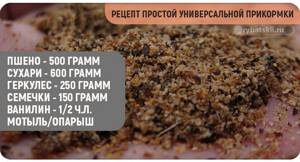
It is better to deliver the bait mixture to the bottom with a regular feeder. It is fixed on a strong fishing line, lowered into the hole and raised sharply. To store a supply of cord, it is enough to prepare the most standard reel.
How to feed properly
When fishing with this gear, you need to feed bream as follows:
- Fill the dump feeder 2/3 full with winter bait and add 1-2 boxes of bloodworms. The remaining part of the volume of the feeder is filled with fertilizer.
- In half of the drilled holes I feed “to the bottom”. To do this, lower the feeder with the bait mixture to the bottom and lift it 10-15 cm above it with a sharp movement of the hand and open it. The remaining holes are fed “at half-water”. With this feeding method, the feeder is opened 0.5-0.7 m above the bottom. The resulting feeding column attracts bream well not only to the tackle installed in this hole, but also in neighboring ones.
- As a rule, starter feeding is enough for the whole day.
- Only in some cases, when the bite is capricious and inconsistent, the holes are supplemented by sending half a feeder of bait into each of them.
- When fishing in a current, feeding is carried out only “at the bottom” - when the feeder is opened above the bottom, the bait will be strongly carried away from the hole.
We recommend reading: Fishing for rotan in winter
Ice fishing technique
Ice fishing with a rocker does not require a special approach; the technique used is quite simple and understandable:
- Determine the promising territory.
- Drill holes.
- Carry out the starting feeding, dropping a dosed amount of bait into each working point.
- Start fishing the holes after 30–40 minutes.
- Place 5-7 bloodworms on the hook. One of them should be crushed between your fingers to enhance the smell.
- Monitor winter gear with a rocker.
- If one shoulder begins to rise, then you should not hesitate, you need to perform a sweep.
- Fishing is carried out using a regular hook. This simple device allows you to effectively remove the catch from the hole and easily unhook the hooks if they get caught on the lower edge of the ice.
For the convenience of fishing with a rocker in the mining areas of the reservoir, it is recommended to use a winter tent; it will both protect you from harsh conditions and make fishing as comfortable as possible.
Installation of a fishing rod for a rocker arm
Winter tackle with a rocker for bream does not require any special frills to the fishing rod. We have already done the main thing - the equipment itself. The main line used is about 2-0.3 mm. Any fishing rod is suitable, as long as it is comfortable for the fisherman. It is better to use a standard one on legs with a key on a reel, or a similar homemade version. Some fishermen prefer fishing rods such as filly or balalaika. This is not important. The main thing is to choose a nod.
The guard is the most common one; when throwing the tackle, it is left in a half-bent position. Store-bought metal or lavsan will do. There is no need to bother with the correct bend, as when fishing with a jig. The rocker for winter bream fishing is much lighter than the summer installation of a donkey with a feeder and the weight of food. The tackle turns out to be quite light and sensitive.
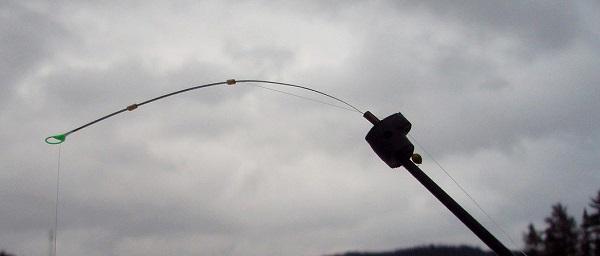
Nod
Instead of hooks, light-accumulating jigs can be placed on leashes. They work especially well at night. Periodically, they can be “recharged” with a flashlight, candle or LED tent lighting. Homemade analogues are ordinary hooks with a drop of firefly varnish applied to the fore-end. Each fisherman on different bodies of water should experiment with the equipment of the tackle for catching bream on a rocker, selecting the most catchy option that is relevant specifically for these specific fishing conditions.
Bait for bream and tricks for using it in winter
The right bait, properly delivered to the fishing point, is the key to successful fishing both in winter and in the open water season. In the case of bream, this is especially evident: a properly organized bait table, taking into account the strength of the current and the season, is practically a guarantee that this fish will come to the fishing spot (but keeping the bream near the bait table is a completely different matter).
Compared to the open water season, winter bait is significantly different. It should be much less nutritious so as not to saturate the fish too quickly at the fishing point, but contain enough protein components so that the capricious winter bream pays attention to it.
In winter conditions, it is highly advisable to use the so-called dump truck feeder. This rather simple device allows you to deliver bait to the very bottom without creating a trail of bait in the water column that attracts all sorts of little things like roaches.
It is also important to take into account the presence of a current, as well as its strength. In areas with strong currents, it is likely that additional holes will have to be drilled so that the bait, washed away by the current, ends up at the required point.
Homemade bait for winter bream fishing usually includes boiled porridge, breadcrumbs, sunflower cake, nutritional value, and the protein component is added with dried blood or milk powder. In this case, it is advisable to mix the bait with sand or soil from the banks of the reservoir, this will avoid rapid saturation of the bream.
Important! You should be careful with large fractions when winter fishing; the fish can quickly become saturated with large particles and animal components, and completely lose interest in the bait on the hooks.
Bloodworms are used almost exclusively as bait in winter. Maggots and caddis fly larvae are used relatively rarely (finding the latter bait option in winter is another challenge). Sometimes a dung worm is also used, but plant baits are almost never used by most anglers.
Varieties and features
There are several modifications to the rocker arm equipment. They depend on the material of manufacture. But they are all divided into only two types.
With sliding leashes
The most sensitive equipment. The leads are passed through the outer and central rings and tied to the main line. The fish, swallowing the bait and feeling absolutely no resistance, boldly pulls out the fishing line. The float begins to sink, and the nod bends towards the bottom.
Blind equipment
In this type of rocker, the leashes are attached directly to the outer rings. When biting, the bream lifts one arm of the rocker, thereby extending the nod or placing the float on the surface of the water. Some effort that the fish will have to apply may alert it. However, if caught in a timely manner, she will not be able to escape.
